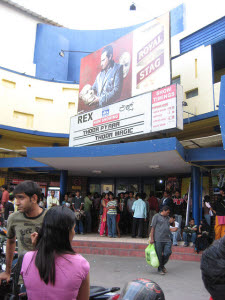by Parth Pandya
Picture this: You enter an extravagantly designed and elegantly lit space that promises you an out-of-the-world experience with all the comforts that it can offer – from huge, plush seats to sturdy carpets to heartwarming fragrances. As you stand and look around, to your left you find a screen playing an action movie where the hero leaps into the air, kicks three baddies at one time, and in slow motion, descends back to earth, all the while achieving the improbable goal of keeping his sunglasses on. To your right is a movie by an auteur where drops of water drip one by one to the floor while the heroine who couldn’t care less about water conservation, keeps staring vacantly outside the window for no apparent reason. Walk straight and you run into the latest Hollywood blockbuster, transferring precious money to studios abroad. Well, it doesn’t take long to realise that this is the place for movies of all ranges, for all ages.
Welcome to the world of the multiplex theater in India – a large complex with a honeycomb of theaters or screens, as they are fashionably referred to, showing a movie for each palate.
Clearly, we are in the midst of a revolution. A revolution in the movie-watching experience. But every revolution has its casualties. Where multiplexes are becoming the norm, single screen theaters have been pushed under the bus.
Ah, yes, the single screen theater. The long-standing bastion of cinema-viewing experience. The church where cinemaphiles of all classes would congregate to immerse themselves in a world alien to them. Those landmarks in cities, those modes of escape from the real world that held sway in India for over eight decades. Yes, the single screen theater.
A movie theater from the olden days would have concepts alien to the modern-day movie-goer. A single screen theater in India of reasonable size would come with a categorization of seats that you don’t find anymore. There would be the stalls – lower and upper, closer to the screen. A more expensive choice would be the balcony, a raised seating platform. Some used to come equipped with dress circle seats and then there was always the box.
Unlike the modern-day multiplex, which, more often than not, is part of a bigger mall, one would go to the single screen theater with the express intent of doing nothing else but watching the movie. Near the entrance would be a ticket window, often separate ones, depending upon whether you had the big bucks to buy a balcony seat, or were content to ogle at your stars from the neck-straining proximity of the lower stall. When a new movie would release, serpentine lines would form in front of the theater. A small atrium would offer protection from the elements while you jostled with the person behind and in front of you, in the manner that lines in India often make you do. The tickets would usually be printed on pink-colored papers, perforated in the center. The person selling the ticket would circle the seat number on it and give it to you. If the movie Gods weren’t going to oblige you, a big “House Full” board, with a white background and red lettering, would be put in front. That invariably would lead to the crowd dissipating. Some would even shake their heads in disbelief. Some may resort to fatalism and decide to come another day. And then the rest, the small minority of smart, adventurous, passionate folks would seek out the only source of salvation left – the famous men in “black”. Those rescuers of trauma, who, for a little price can still let you into that theater. Never mind that you may end up in lower stall if you had balcony in your sights. Never mind that you may have gone as a couple but may find two different seats to watch the movie from. If you desperately wanted to get in, no matter what, you went through them.
Once the time for the movie was nigh, you walked in through those majestic structures. Ranging from the baroque to the very ordinary, the theaters would invariably have a choices of architectural styles on offer. Long staircases leading to your seat, an usher, plainly dressed, unlike the smartly-dressed-in-suit ones found in multiplexes, shining his torchlight to make sure you get to your moderately-comfortable viewing spot, and after the riff-raff has settled down, the dimming of lights and the shining screen – ah, the memories! And how can one forget the advertisements, the trailers of upcoming movies and the inevitable shaking of the screen till the projectionist gets it right?
Intervals would typically see a mad scramble to get some food and cold drinks. You need to remember that the capacity of a single screen theater far exceeds that of a screen in a multiplex. This meant swelling crowds everywhere during the interval, whether it was the line for ‘batata wada’ or the restrooms. When the movie got over, an unending stream of people would accompany you through the exit. If you ever exited out to a busy street, reality would wake you up with honking horns and glaring lights, unlike the glitz and glamour of the mall. Like a social leveler, the single screen theater had tickets that all members of society could afford to purchase. A family could have an outing without emptying their pockets, unlike the multiplex prices that may not be within reach for all.
That would be your experience in a big single screen theater. The Metros and Maratha Mandirs of Mumbai. But, at the other end of the spectrum, with a different setting altogether are the teeny tiny theaters. Nestled in a small nook of the old part of a city. Playing a Hindi movie from the 70s or a C grade movie made by Kanti Shah. Some were adept enough to have the promise of air conditioning. Where men fatigued by their daily labours would go inside for a three-hour nap, stretching their legs across the seats.
But these experiences are on their way out. Movie watching is not the same anymore, with the sanitized, contained world of the multiplex. The single screen theaters are losing their way in this modern world. This is typically true for the larger cities. Take Mumbai, for instance. Iconic theaters that once existed now no longer dot the landscape. Hindmata, Imperial, Dreamland, Novelty, Strand have been torn down and reused to serve some other purpose. Apsara, which had premiered with Sangam in 1964, has also passed us by. This malaise has also spread to smaller cities. Majestic Talkies in Ajmer, Rajasthan’s oldest cinema, which began in 1929, is packing up.
It is a poignant commentary of transformation, this move towards tearing the old and introducing the new. Modernism may swoop in to take the movie experience to a better place but it remains a fact that every time a big theater packs up, a little part of the city’s history dies along with it.
Pic from https://www.flickr.com/photos/






